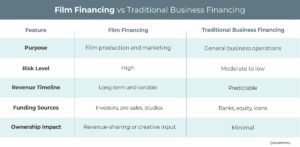
Navigating Film Financing: Key Strategies for Funding Movie Production
Content
The film industry is as much about business as it is about art. Behind every blockbuster or indie-film success is a carefully planned strategy to secure the funding necessary to bring a creative vision to life. Film financing is a critical process that involves raising the capital needed to produce, market, and distribute movies.
This blog explores film financing, the methods used to fund movies, and how filmmakers can navigate this complex yet essential aspect of the industry.
What Is Film Financing?
Film financing refers to the process of securing the money required to produce a film. This financing covers a wide range of expenses, including pre-production, shooting, post-production, marketing, and distribution. Financing a movie often involves a mix of investors, production companies, and financial strategies tailored to the scale and goals of the project.
Key Features of Film Financing:
- Diverse Funding Sources: Includes private investors, studios, grants, and crowdfunding.
- Risk and Reward: High potential returns but significant financial risk.
- Creative and Business Collaboration: Aligns artistic vision with financial feasibility.
Methods of Film Financing
- Studio Financing
- Studios provide upfront funding in exchange for ownership or distribution rights. This is common for big-budget films.
- Equity Financing
- Private investors contribute funds in exchange for a share of the film’s profits.
- Debt Financing
- Loans secured against future revenue, such as box office returns or pre-sales agreements.
- Crowdfunding
- Through networking, special events, and online platforms, filmmakers can raise small contributions from a large number of people.
- Pre-Sales Agreements
- Selling distribution rights to international markets before production begins.
- Tax Incentives and Grants
- Governments or organizations offer financial incentives to encourage local film production.
- Gap Financing
- A loan to cover the difference between secured funds and the total budget, often secured against unsold distribution rights.
- Co-Productions
- Partnering with other production companies to share costs, risks, and returns.
Who Benefits from Film Financing?
Film financing is essential for:
- Independent Filmmakers: Seeking to bring creative ideas to life without studio backing.
- Production Companies: Managing budgets for large-scale or multi-film projects.
- Investors: Looking for high-reward opportunities in the entertainment industry.
- Studios and Distributors: Securing content to meet audience demand.
- Regional Economies: Boosting local industries through film incentives and employment.
Benefits of Film Financing
- Enables Creativity
- Provides the financial backing needed to bring ambitious ideas to the screen.
- Attracts Talent
- Well-funded projects are more likely to attract top-tier actors, directors, and crew.
- Reduces Risk
- Diversified funding sources minimize financial exposure for individual investors or companies.
- Supports Marketing and Distribution
- Financing extends beyond production, ensuring the film reaches its target audience.
- Drives Economic Growth
- Film production creates jobs and boosts local economies through location shoots and related activities.
Challenges of Film Financing
- High Risk
- Films are unpredictable investments with no guarantee of box office success.
- Complex Contracts
- Financing agreements often involve detailed negotiations and legal oversight.
- Creative Compromises
- Investors may demand changes to the script or casting to align with market trends.
- Revenue Delays
- Earnings from box office, streaming, or distribution deals can take months or years to materialize.
- Distribution Challenges
- Securing global distribution deals is often challenging, yet it can be critical to recouping costs.

Real-World Example: Film Financing in Action
Scenario: An independent filmmaker has a $5 million budget for a feature film but has only secured $2 million through private investors.
Solution: The filmmaker raises $1 million through a pre-sales agreement with international distributors, secures a $500,000 tax incentive from the filming location, and uses gap financing to cover the remaining $1.5 million.
Outcome: The film is completed on budget, released theatrically, and achieves success on streaming platforms, generating significant returns for investors.
How to Navigate Film Financing
- Develop a Strong Pitch
- Create a compelling proposal with a clear budget, revenue projections, and creative vision.
- Leverage Tax Incentives
- Research and apply for tax rebates or grants in film-friendly locations.
- Build Relationships with Distributors
- Secure pre-sales or partnerships to guarantee revenue streams.
- Use Crowdfunding Strategically
- Engage your audience early to build excitement and secure funding.
- Work with Industry Experts
- Partner with experienced producers, financial advisors, and legal teams.
Tips for Choosing Film Financing Options
- Understand Your Needs
- Determine the exact budget and funding gap before approaching investors or lenders.
- Evaluate Risk Tolerance
- Choose financing options that align with your financial and creative goals.
- Seek Transparent Agreements
- Ensure all contracts clearly outline terms, ownership, and profit-sharing arrangements.
- Diversify Funding Sources
- Combine multiple bespoke financing methods to reduce reliance on a single source.
- Focus on ROI
- Present clear plans for revenue generation, including box office, streaming, and licensing opportunities.
Conclusion
Film financing is a crucial aspect of bringing creative visions to life, enabling filmmakers to overcome financial hurdles and focus on storytelling. By leveraging a mix of traditional and innovative financing methods, filmmakers can secure the resources needed to produce, market, and distribute their projects successfully.
Whether you’re an independent filmmaker or part of a major studio, understanding the intricacies of film financing can make the difference between a project staying on paper or shining on the silver screen. With the right approach and strategic planning, film financing can turn creative dreams into cinematic reality.
Contact us to assess your film company’s best approach to overcome funding constraints, and ensure reliable financing to meet production goals.
Key Takeaways
- Behind every blockbuster or franchise success is a carefully planned strategy to secure the funding necessary to bring a creative vision to life.
- Film financing is a crucial aspect of bringing creative visions to life, enabling filmmakers to overcome financial hurdles and focus on storytelling.
- Understanding the intricacies of film financing can make the difference between a project staying on paper or shining on the silver screen.
ABOUT eCapital
At eCapital, we accelerate business growth by delivering fast, flexible access to capital through cutting-edge technology and deep industry insight.
Across North America and the U.K., we’ve redefined how small and medium-sized businesses access funding—eliminating friction, speeding approvals, and empowering clients with access to the capital they need to move forward. With the capacity to fund facilities from $5 million to $250 million, we support a wide range of business needs at every stage.
With a powerful blend of innovation, scalability, and personalized service, we’re not just a funding provider, we’re a strategic partner built for what’s next.


 Fact-checked by:
Fact-checked by: 